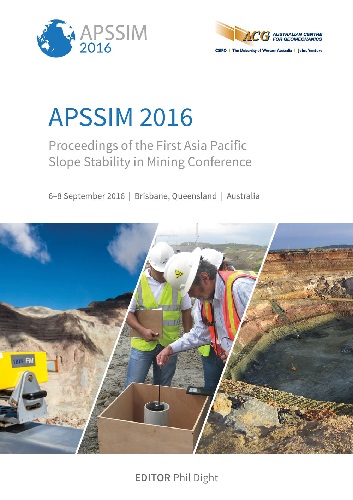Discrete fracture network modelling for hard rock slopes

|
Authors: Weir, FM; Fowler, MJ |
DOI https://doi.org/10.36487/ACG_rep/1604_06_Weir
Cite As:
Weir, FM & Fowler, MJ 2016, 'Discrete fracture network modelling for hard rock slopes ', in PM Dight (ed.), APSSIM 2016: Proceedings of the First Asia Pacific Slope Stability in Mining Conference, Australian Centre for Geomechanics, Perth, pp. 157-168, https://doi.org/10.36487/ACG_rep/1604_06_Weir
Abstract:
The design of excavations in rock must, implicitly or explicitly, consider the influence of small and large scale geological structures. For most hard rock sites, the complexity of a fractured rock mass is best captured using a three-dimensional fracture system model based on field data. A discrete fracture network (DFN) approach involves stochastic modelling of the smaller scale, non-deterministic structures. For slope stability projects DFN modelling provides a valuable geotechnical tool for visualisation of a rock mass, identification of likely failure mechanisms and a method for considering uncertainty both in terms of natural stochastic variability and sampling. This paper presents a suite of DFN modelling undertaken for the design of a large open pit in Australia. The model inputs and development are briefly presented, along with the various applications of the DFN modelling. A key advantage of the DFN approach for design studies is its probabilistic application to analyses and results. Multiple realisations of the same model were generated for four structural domains, with the stability analysis carried out on each iteration. The proportion of unstable slope for a range of conditions is compared with results from traditional kinematic and statistical analyses.
Keywords: geological structures, probabalistic, slope stability
References:
Barton, C & La Pointe, P 1995, Fractals in the Earth Sciences, Plenum Press, New York, p. 265.
Coates, DF 1981, Rock Mechanics Principles, Energy, Mines and Resources Canada, Monograph, p. 874.
Dershowitz, WS, Lee, G, Geier, J, Foxford, T, La Pointe, P & Thomas, A 2011, FracMan – Interactive Discrete Feature Data Analysis, Geometric Modelling and Exploration Simulations: User Documenation, version 7.4, Golder Associates, Seattle.
Gasc-Barbier, M, Ballion, A & Virely, D 2008, ‘Design of large cuttings in jointed rock’, Bulletin of Engineering Geology and the Environment, vol. 67, pp. 227–235.
Geier, JE & Thomas, AL 1996, Discrete-feature Modelling of the Aspo site: Discrete Fracture Network Models for the Repository Scale, Report 96:5, Swedish Nuclear Power Inspectorate, Stockholm.
Grenon, M & Hadjigeorgiou, J 2008, ‘A design methodology for rock slopes susceptible to wedge failure using fracture system modelling’, Engineering Geology, vol. 96, pp. 78–93.
Mauldon, M & Dershowitz, WS 2000, ‘A multi-dimensional system of fracture abundance’, Geological Society of America Annual Meeting: Abstracts with Programs, Nevada, 32(7).
Priest, SD 1993, Discontinuity Analysis for Rock Engineering, Chapman and Hall, London.
Rogers, S, Moffitt, K & Chance, A 2006, ‘Using realistic fracture network models for modelling block stability and groundwater flow in rock slopes’, in Canadian Geotechnical Conference, Vancouver, pp. 1452–1459.
Starzec, P & Andersson, J 2002, ‘Probabalisitic predictions regarding key blocks using stochastic discrete fracture networks – examples from a rock cavern in south-east Sweden’, Bulletin of Engineering Geology and the Environment, vol. 61, pp. 363–378.
Terzaghi, RD 1965, ‘Sources of error in joint surveys’, Geotechnique, vol. 15, pp. 287–304.
Weir, FM & Fowler, M 2014, ‘An introduction to discrete fracture network modelling and its geotechnical applications’, in AusRock 2014: Third Australiasian Ground Control in Mining Conference, Sydney.
Weir, FM, de Ambrosis, A & Fowler, M 2014, ‘Discrete fracture network modelling for tunnel design in the Sydney Basin’, in Proceedings of the 15th Australasian Tunnelling Conference 2014, Sydney, pp. 219–228.
© Copyright 2024, Australian Centre for Geomechanics (ACG), The University of Western Australia. All rights reserved.
View copyright/legal information
Please direct any queries or error reports to repository-acg@uwa.edu.au
View copyright/legal information
Please direct any queries or error reports to repository-acg@uwa.edu.au